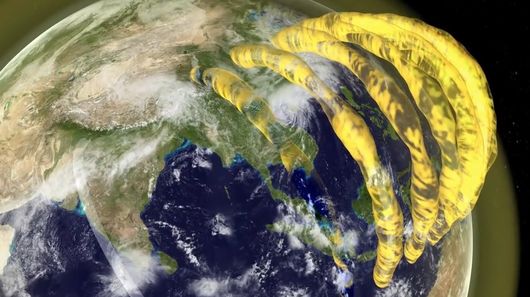University student maps plasma tubes in the sky
June 3, 2015

Enormous plasma pipes above the Earth are created when ionizing radiation from the sun strikes atoms in the ionosphere (Credit: University of Sydney)
Using the Murchison Widefield Array (MWA) radio telescope in the Western Australia desert, a Sydney University student, Cleo Loi, has discovered enormous plasma pipes in the Earth’s upper atmosphere. Thought to be responsible for possible radio interference with satellite navigation systems, the presence of these objects has been predicted for over 60 years, but never before seen. By imaginatively using the radio telescope to observe in 3D, Loi was able to image large areas of the sky using the fast photography capabilities of the MWA to produce a movie that shows the motions of the plasma in real-time.
The Earth is surrounded in space by the magnetosphere. This layer is believed to be generated by the movement of liquid iron inside a shell of iron, nickel and other metals, deep within the center of the earth’s core, which creates a magnetic field that extends out beyond the confines of the Earth to wrap our planet in a protective layer that deflects many types of ionizing radiation.
The innermost level of the magnetosphere is the ionosphere, and the layer beyond that is the plasmasphere. It is in this region of magnetic fields that atoms in the upper atmosphere are ionized (that is, have electrons stripped away) by the solar wind constantly flowing out from the sun, generating great plumes of plasma and vast swathes of free electrons in the sky. Here, in an area riddled with many different types of plasma structures, is where the new plasma tubes have been located and where they interact with the magnetic field to create magnetic-line-following ducts.
"We measured their position to be about 600 kilometers above the ground, in the upper ionosphere, and they appear to be continuing upwards into the plasmasphere," said Loi, from the School of Physics at the University of Sydney. "This is around where the neutral atmosphere ends, and we are transitioning to the plasma of outer space. The discovery of the structures is important because they cause unwanted signal distortions that could, as one example, affect our civilian and military satellite-based navigation systems. So we need to understand them."
While still an undergraduate, Loi and her colleagues used the 7 sq km (2.7 sq mile) MWA array as a type of binocular apparatus, by dividing the 128 antennas of the array into two separate receiving areas. In this way they effectively created two "eyes" which, when combined with triangulation, enabled them to build a three-dimensional dynamic map of the plasma tubes over a large area.
"This is like turning the telescope into a pair of eyes, and by that we were able to probe the 3D nature of these structures and watch them move around," Loi said. "We saw a striking pattern in the sky where stripes of high-density plasma neatly alternated with stripes of low-density plasma. This pattern drifted slowly and aligned beautifully with the Earth's magnetic field lines, like aurorae.”
Already a dominant instrument in the multi-continent Square Kilometre Array (SKA), using the MWA to provide 3D vision of objects is already piquing the interests of scientists to conduct a great deal more analysis on the formation of these plasma structures.
"We realized we may be onto something big and things got even better when we invented a new way of using the MWA," revealed Loi. "We were able to measure the spacing between them, their height above the ground and their steep inclination. This has never been possible before and is a very exciting new technique."
However, before any such research could be made a reality, Loi first had to overcome the skepticism of senior colleagues who thought that her results from the observations may have been a little too enthusiastic and premature.
"It is to Cleo's great credit that she not only discovered this but also convinced the rest of the scientific community," said Loi's supervisor Dr Tara Murphy, also of the School of Physics at the University of Sydney. "As an undergraduate student with no prior background in this, that is an impressive achievement. When they first saw the data, many of her senior collaborators thought the results were literally 'too good to be true' and that the observation process had somehow corrupted the findings. But over the next few months, Cleo managed to convince them that they were both real and scientifically interesting."
A better knowledge of the make-up of these ducts also means that astronomers can take such phenomena into account when using radio telescopes. Especially as, when dealing with such fundamentally weak radio signals coming in from astronomical objects such as quasars, pulsars, and black holes. The more interference that can be cut out and the clearer the signal received, the better the resolution and data gathering will be.
Cleo Loi has been awarded the 2015 the Astronomical Society of Australia's Bok Prize for her work, and is the lead author of research recently published in the journal Geophysical Research Letters.
The short video below shows a reconstruction in 3D of the plasma tubes floating above the Earth.
Source: The University of Sydney
http://www.gizmag.com/plasma-tubes-ionosphere-cleo-loi/37843
